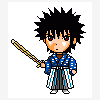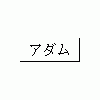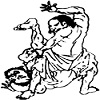Jesli ktos by mial nadmiar wolnego czasu to prosze przetlumaczyc poklon
W skrocie chodzi o to, ze to co cwicza ludzie w Budojo wydaje sie byc osobistym pomyslem Inaby sensei i nie ma nic wspolnego z Kashima shin-ryu!!
quote:
--------------------------------------------------------------------------------
Originally posted by Stanley Ang:
Sorry, but can I clarify whether Kono sensei is practicing Aikido or Kashima shin-ryu?
--------------------------------------------------------------------------------
He is practicing Aikido, or rather he is NOT practicing Kashima-Shinryu--in either a formal or a practical sense.
It cannot be KSR, in a formal sense, because Mr. Kono's only exposure to KSR was through Inaba Minoru, the head Aikido instructor at the Meiji Grand Shrine in Tokyo. Mr Inaba has worked a bit of kenjutsu derived from KSR (which is NOT the same as "KSR kenjutsu"--see below), and some other weapon training into his aikido curriculum at the Meiji Grand Shrine. Neither he nor his teacher, Tanaka Shigeo, however, has any formal connections with the current KSR soke or shihanke, and neither has any KSR license or diploma from either Kunii Zen'ya (the previous soke/shihanke) or Seki Humitake (the current shihanke).
Dr. Seki's formal position on Mr. Inaba is as follows:
______________________________
"In recent months I've become aware of a considerable amount of discussion concerning Inaba Minoru and his relationship to the Kashima-Shinryu. Mr. Inaba and his students appear to have established some connections in North America and Europe . . . I believe, therefore, that it is worthwhile taking a bit of space . . . to clarify who Inaba is and what his credentials are, for the benefit of Kashima-Shinryu students in America.
"The Kunii family, the Kashima-Shinryu soke, has placed full and exclusive authority over the teaching of Kashima-Shinryu and the licensing of instructors in the hands of the shihanke. Accordingly, only those individuals authorized directly by me, through the Kashima-Shinryu Federation of Martial Sciences, can claim to be a part of the Kashima-Shinryu tradition passed on by Kunii Zen'ya.
"Mr Inaba has not received any official diploma from Kunii Zen'ya, from me, or from the Kashima-Shinryu Federation of Martial Sciences, but he has, at the request of Kunii Zen'ya Sensei's widow, received permission to teach kenjutsu at the dojo of the Meiji Grand Shrine.
"Mr. Inaba, the senior Aikido instructor at the Meiji Grand Shrine dojo, had studied Kashima-Shinryu under Zen'ya Sensei for a little less than a year, prior to Zen'ya's death in 1966. Several years later, his supervisor asked Mrs. Kunii for permission for him to teach Kashima-Shinryu to the shrine attendents, noting that Shinto authorities do not recognize Aikido as proper martial training for shrine attendents, because it lacks any form of *harai* (exorcism). Under the circumstances, it was determined that this request could not be refused.
"Nevertheless, at the time I firmly cautioned Inaba that the permission granted him extends only to the teaching of fundamental kenjutsu techniques (because his period of training was far too short to learn and understand the arcana of Kashima-Shinryu) and that he has no
authority to issue Kashima-Shinryu diplomas to his students. As far as I know, he has complied with these restrictions.
"Thus Inaba's formal status within Kashima-Shinryu is that of teaching fundamental kenjutsu techniques within the framework of teaching Aikido at the Meiji Shrine dojo. As the 19th generation shihanke, and a witness to the original agreement, I continue to recognize Inaba's right to teach under these conditions and limitations (but not the right of his *students* to teach Kashima-Shinryu in Japan or abroad), in spite of the fact that his relationship with the Kunii family is no longer a cordial one."
-----Seki Humitake
19th Generation Shihanke
Kashima-Shinryu
(originally published in *Ryubi*, 1997)
___________________________
Perhaps even more importantly, what Mr. Kono--or any other students of Mr. Inaba--practice is not KSR in any practical sense, either. This is an issue that goes way beyond any possible objections that statements about formal legitimacy may involve hair-splitting or bias, or that they may be irrelevant to students who simply want "to learn the art."
Aikido and Kashima-Shinryu have elements in common, but they are really fundamentally different in strategy, philosophy and patterns of movement. (A rough analogy might be the differences and similarities between Islam and Christianity.)
If one tries to teach Aikido and KSR techniques at the same time one will NOT (cannot) perform the KSR techniques correctly (in so far as "correctness" is defined by members of KSR). The sword techniques and kata taught might share some similarities to KSR, but the key elements (i.e., the very elements that give KSR its unique identity) will either be corrupted or missing altogether. At that point, they NO longer are KSR techniques.
This is emphatically the case with the kenjutsu kata that Mr. Inaba and his students practice. Mr. Inaba's interpretation of KSR kata is heavily flavored by Aikido and thoroughly reshaped by minimal initial exposure to the real thing compounded by 3 decades of practicing in isolation. Many of the kata are unrecognizable to students of orthodox Kashima-Shinryu; most of the basic patterns and rhythms of movement and application of power are.
One easy way to see this is to compare the movements and form of Mr. Inaba and his students with that of Kunii Zen'ya and his students in the 1960s, and with that of Seki Humitake and his students today (footage of Kunii, Seki and their students can be seen in the 11 volume video series produced a couple of years back by Gaisei International, in Japan; still photos, taken from the video series, can be seen in the May 1999 issue of *Hiden* magazine). The differences between the postures and application of energy of Mr. Inaba (and his students) today and those of Kunii Zen'ya are also strikingly clear in the photographs that appear in the recent *Aiki News* articles (issue #s 123 & 124) on Inaba; the photo of Mr. Inaba performing kesa-giri in 1967 looks pretty much like what a student of KSR today with a year or so's training would look like; the photos of Mr. Inaba and his students from the 1970s and later look VERY different, and very much like Aikido.
In sum, it behooves no one, least of all Mr. Inaba and his students, to label the kenjutsu they practice as "Kashima-Shinryu." What it is in fact, is a style of sword work *derived from* KSR. Mr. Inaba has found his own path in Aikido and his own insights about swordsmanship. His kenjutsu deserves to be seen and evaluated in that light, and in terms of its contribution to Aikido, and not confused by its remote origins in a fundamentally different art, learned from a teacher (Kunii Zen'ya) who was publicly contemptuous of Aikido.
------------------
Karl Friday
Dept. of History
University of Georgia
Athens, GA




 Temat jest zamknięty
Temat jest zamknięty





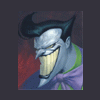

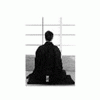


 FaceBook
FaceBook


